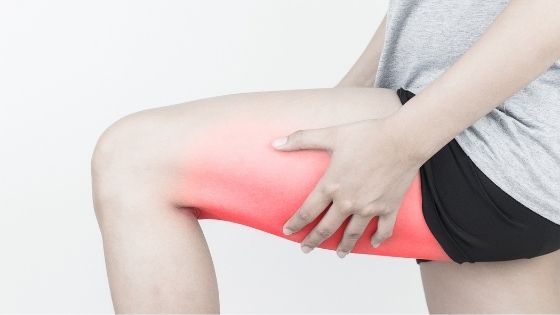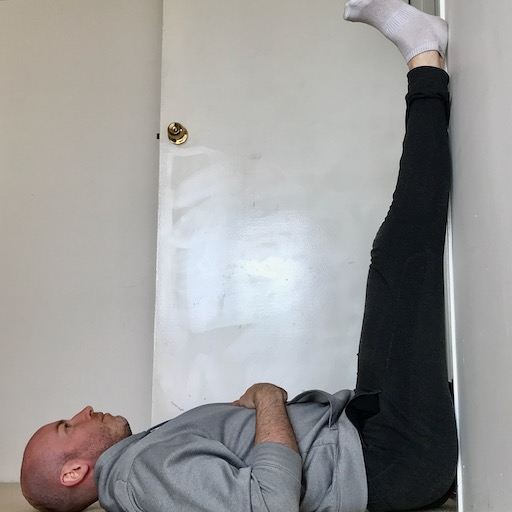Some people (me included) have tight hamstrings. They're difficult, and sometimes uncomfortable, to stretch. When I came across this version of a hamstring stretch that's easy and comfortable, I had to share it.
More...
Why hamstrings flexibility is important
Hamstring tightness is an injury risk factor.
Straightening the leg stretches both the hamstring muscles at the back of the thigh and the Sciatic nerve. The longest nerve in the body, the Sciatic nerve runs from your spine down to your toes. Its journey takes it from your lower back, through your buttock and down the back of your leg.

The less elastic a muscle is the more likely it is to tear during rapid uncoordinated actions.
Incidentally, the actual length of the muscle is not as important here as the quality of movement. Static stretching, where we stretch and hold develops movement range. Dynamic stretching on the other hand involves moving into the stretched position repeatedly and relatively quickly. This form of stretching has its risks, but it is more functional as it can be tailored to rehearse a sports action.
For example, a controlled leg raise or leg swing can mimic a kicking action in football or a martial arts move. With dynamic stretching, although we're training movement range, several muscles have to coordinate their actions.
For the purposes of safety and efficiency, we'll focus on static stretching with a door frame.
How hamstring tightness can affect your posture
From a postural perspective, the hamstrings are also important. You might find that by performing this hamstrings stretch regularly, your posture improves.
They attach up into the buttocks onto the sitting bone, otherwise known as the ishcial tuberosity. Consequently, your hamstrings pull the pelvis back into posterior tilt. This in turn flattens the lumbar spine.
When driving, for example, your legs can be nearly straight as they reach for the car pedals. If tight, the hamstrings will flatten the back excessively placing stress onto your lumbar tissues. Over a long journey, this may result in low back pain.
Bending and lifting
The hamstrings are equally important in bending and lifting actions.

As we bend forwards to pick up a box in the office or perform a dead-lift in the gym, the bending action comes from the hips and spine. The pelvis tilts on the hips and the lumbar spine bends. Both of these actions are important.
Hamstring tightness can limit pelvic tilt. As a result, the lumbar spine contributes more to the total bending action than need be. Over time this can lead to accumulated strain in the lower back and severe injury. Stretching the hamstrings and re-training the bending action can increase the contribution of the pelvic tilting action and de-emphasise the lumbar spine motion.
Dealing with Sciatic nerve pain by stretching your hamstrings
Finally, tightness in the Sciatic nerve may occur as a result of back pain. This often results from inflammation of the lumbar tissues around the discs and facet joints. Resultant swelling can spread to the Sciatic nerve causing pain (Sciatica). When the back condition has eased, a person can be left with tightness of the nerve, which reduces its normal sliding as the knee bends and straightens.
By using this stretch, the sciatic nerve is lengthened and if the toes and foot are pulled towards the knee (dorsiflexion) the emphasis on the nerve is increased. A tight nerve can cause a tingle and ache in the calf and sometimes the toes. Providing this is mild and reduces as the stretch is slowly repeated, the nerve is stretching out.
However, a word of caution - following back pain - if the tingling is intense or if it occurs in daily activities such as sitting and driving you should see a physiotherapist.
Intense tingling is a sign that the nerve is compressed and requires specialist treatment.
Starting position and instructions for the hamstrings doorframe stretch
Start by lying on the floor in a doorframe, with your hips level with it. Bend your left leg and place your left foot on the upright of the doorframe, whilst keeping your right leg straight and pressed into the floor. Straighten your left leg, sliding your left heel up the doorframe as you do so. Next extend your leg slowly, tightening your quads at the same time. Hold the stretched position for 30-40 seconds, breathing normally.

Lie back and get comfortable, allowing the leg muscles to relax
How to vary this hamstrings stretch to make it more effective for you
Move your whole body forwards or backwards so that the door frame is at waist or knee level.
This will create a greater or lesser amount of hip flexion and change the intensity of the exercise. Additionally, keeping your knee unlocked will reduce the stretch on the lower hamstrings towards the knee and increase the emphasis on the upper portion of the muscle up into the buttock. Drawing your toes towards you places a greater emphasis on the neural (nerve) structures within the leg and stretches the Sciatic nerve.
Points to note while performing the hamstrings doorframe stretch
Make sure that your heel stays on the doorframe.
If you find that your foot does not slide easily up and down it, keep your sock on to increase slip.
If you are unable to straighten your leg fully, record the distance that your heel raises up the doorframe. Providing you place your hips in the same position on the floor, you can use the height of your heel on the doorframe to track the improvement in your range of movement over a number of weeks.

Had a facet joint issue last week. Resolved pretty quickly but this has definitely helped. Thanks Paul.
Glad to hear you found it helpful Leigh, hope you’re doing well
Keep functioning ,remarkable job!
Hi everyone, it’s my first pay a quick visit at this site, and post is in fact fruitful designed for me, keep up posting these content.